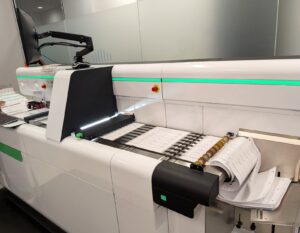Northwestern University’s athletic facilities lacked adequate space to store gear for its 500+ student athletes. High-density storage systems were installed to organize athletic gear and consolidate services.
Everything about the Big Ten conference is big: big enrollments, big endowments, and big athletic programs. Until recently, Northwestern University’s athletic facilities were the exception to that rule. The prestigious institution lacked adequate space to store gear for its 500+ student athletes, and teams were housing athletic equipment throughout various areas with only one small, central location for sports storage. As a result, student athletes had to spend a lot of time moving between various locations to work out, go to practice, grab a meal, and attend tutoring sessions.
“Before Northwestern built the field house, the Wildcats might have had the worst facilities in the power five. Northwestern’s 19 sports and 504 student athletes shared a single, modest weight room, which is almost unimaginable for a Big Ten school in the current arms race.”
– Street and Smith’s Sports Business Journal
Supporting Student Athletes
The need for a new approach to the university’s athletic equipment storage was obvious. When the university began considering concepts for a new field house, the planning team decided that a top priority would be to support all student athletes in a new and more complete way. They wanted athletes to be able to spend more time training and studying, and less time in transit from place to place for various activities.
They decided to bring all the teams and their gear together under one roof, along with a dining area, academic support services, sports medicine, workout facilities, and more. In addition to better serving student athletes, this strategy would offer practical opportunities to streamline staff tasks like laundry and equipment repair. It would also allow programs to design storage solutions that would promote efficiency by consolidating athletic gear and optimizing space.
“I don’t want to build something and just hope that it works out. Let’s go ahead and measure an extra-large helmet, for example, to be sure we have a system that can handle everything.”
– Michael Valentine, Assistant Athletic Director for Equipment
In the Olympic sports area, each Spacesaver unit is configured to store gear specific to that sport. Lacrosse sticks are hung on posts to keep them tidy and protected, and hanging rods provide convenient storage for jerseys and other apparel.

Planning for Success
Because cramped and scattered storage can lead to inefficiency and even lost or damaged equipment, the university’s equipment managers jumped at the chance to design efficient storage systems that would provide a place for everything. The planning team visited more than 60 other campuses to get inspiration and to learn from their counterparts’ experiences.
One of the most common suggestions was to really think through storage needs and to be realistic about the space needed to store athletic gear. Because they were determined to get it right the first time, the planning team called in Chicago-based Spacesaver storage consultants to gain a better understanding of the available options. The Spacesaver consultants worked with the planning team and the project architects to design compact storage systems for the football program and for the university’s Olympic sports, which include soccer, lacrosse, and tennis.

Quick, Convenient Access
The result of all that effort is a facility that makes it much easier for staff to provide student athletes with the services and equipment they need. In the Olympic sports equipment area, for example, a large work table serves as a laundry station for twelve sports. In both the football and Olympic sports areas, clothing and equipment is stored on Spacesaver high-density systems, which consist of shelving units that move along rails. Each unit is configured to house specific gear for a particular sport with the goal of protecting equipment and providing quick, convenient access for staff.






